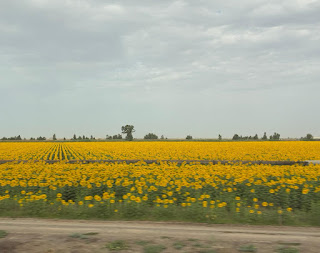We left Seville on the bus with our Guide Juan at the helm. we were on our way to the southern most part of Spain to catch the ferry to Morroco.
We passed a prosperous looking agricultural area - paddocks of sunflowers, beef cattle, crops in the ground. It seems a healthy region - although while we were in Seville I was getting notifications that the air quality was ‘unhealthy’ and was told it was the hot winds blowing in from Africa.
We arrived in Tarifa - a coastal town known for its beach sides. We saw lots of caravan and camping places coming into the town, and we saw many kites in the air indicating there were a lot of people kite surfing.
The town is bigger than I expected but looks like it could be a pleasant place to stop for a coastal break. The port was quite large and the ferry took passengers and cars on what looking like a very regular schedule during the day.
We lunched with Juan to say goodbye - enjoying Tuna TarTar; Spanish Charcuterie board; Gambo Salad and Tiramisu for desert. Something a few of us wondered whether was wise before we boarded the ferry as the wind looked strong and the water looked choppy.
We walked along the waterfront and came to the spot where the Med meets the Atlantic - taking a great picture.
Boarding the ferry was relatively painless and in an hour we were disembarking in Morroco.
We met our new guide Omar who then shepherded us into another bus for the trip to Chefchaouen. Within five minutes we stopped at the best place to exchange our money and to buy alcohol! We were introduced to the different way Morrocons do commerce - cash is king - and we expect there are friends and family ‘who can give a great deal’ involved here!
The bus then took the 3.5 hours to Chefchaouen. The roads were great - much better than at home in the Mid North Coast - not a pothole in sight. The traffic appeared a little chaotic in the town areas - very few lines and it seems cars just made up the lanes as they went along.
Leaving Tangier and heading south east we went through quite a few mountainous areas (this surprised me) and saw a variety of agriculture - crops, animals and pastures of varying types and sizes.
Water is king here - all the towns are located on reliable water sources (which means near rivers or mountain springs). The government made a dam lake for agricultural purposes to boost the trade in Olivers, Apricots and other crops to boost the economy.
Apparently Morroco is making strong headway with economic trade - they make five types of cars here and export to European countries - including Peugeot
As we approached Chefchaouen the road narrowed and the condition worsened but there were roadworks which I think will mean that wont be for long.
All along the highway we saw Morrocan flags flying…I tried to get an explanation but was fobbed off as I dont think my question was understood - I was just told nothing special but there was a lot of work in making these permanent flag pols - in groups of three - every few hundred metres along the road!
We arrived at Chefchaouen and our bus could only take us so far as our hotel is in the old city or Medina as they call it here which what’s very small streets. So, a small minivan arrived - our luggage was loaded and driven to wait for us at the hotel, while we walked 15 minutes to get there.
Our hotel is a Reidan - a house that offers accommodation. It is very Morrocan - both in design and decoration. All the rooms are on different levels with halls that are open in order to maximise the air flow through the building to keep it cool - only 36 the day we arrived but can get a lot warmer. With all the alleys and on the side of the hill, I imaging air flow is critical!
We went for a short orientation walk before heading of a dinner in a restaurant on the square (around the corner from our hotel). We enjoyed Arabiata Chicken Tagine with Vegetable Couscous which was absolutely delicious!
After such a big day..we hit bed early and slept!










No comments:
Post a Comment